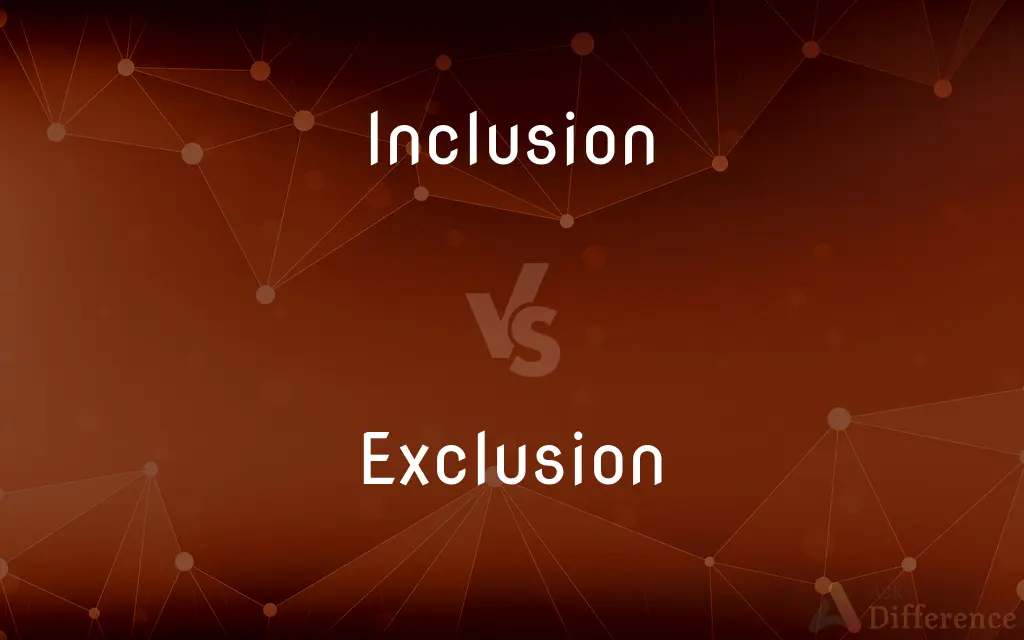Inclusion vs. Exclusion — What's the Difference?
By Fiza Rafique & Maham Liaqat — Updated on May 2, 2024
Inclusion involves incorporating and valuing diverse individuals or groups, whereas exclusion refers to deliberately leaving out or disregarding certain people or groups.

Difference Between Inclusion and Exclusion
Table of Contents
ADVERTISEMENT
Key Differences
Inclusion is centered on the idea of embracing diversity in environments like workplaces, schools, and communities, ensuring everyone feels valued and part of the whole. Conversely, exclusion is the process or practice of deliberately not including certain individuals or groups, which can foster feelings of isolation or discrimination. This distinction is crucial in understanding how different organizations or societies approach diversity and integration.
Inclusive practices are designed to create opportunities for all individuals to contribute and participate, often resulting in increased innovation and satisfaction. On the other hand, exclusion limits these opportunities for certain groups, which can lead to a lack of diversity in ideas and perspectives and potentially decrease overall morale and productivity.
Inclusion seeks to break down barriers that prevent individuals from fully participating, such as physical obstacles, social prejudices, or systemic biases. Whereas exclusion might maintain or even create these barriers, whether intentionally through policies or inadvertently through negligence, reinforcing societal divisions or inequality.
Policies promoting inclusion often involve active measures such as affirmative action, accessibility enhancements, and diversity training. In contrast, exclusionary practices may be manifested in segregation, restrictive legislation, or discriminatory hiring practices, which systematically disadvantage certain groups.
In social contexts, inclusion enables individuals from various backgrounds to feel respected and acknowledged for their contributions and identities. On the other hand, exclusion can lead to social alienation and can perpetuate stereotypes and prejudices, undermining social cohesion.
ADVERTISEMENT
Comparison Chart
Definition
The act of including or being included within a group or structure.
The act of excluding or being excluded from a group or structure.
Objective
To ensure everyone has equal access and opportunities.
To limit access and opportunities to specific groups.
Methods
Affirmative action, diversity training, accessible environments.
Segregation, restrictive legislation, discriminatory practices.
Impact on Individuals
Increases sense of belonging, self-esteem, and participation.
Creates feelings of isolation, marginalization, and inequity.
Social Consequences
Promotes diversity, equality, and integration.
Reinforces divisions, stereotypes, and social inequality.
Compare with Definitions
Inclusion
Embracing differences.
The festival promoted inclusion by celebrating various cultures.
Exclusion
Policy of exclusivity.
The club’s exclusion policy has been criticized for being discriminatory.
Inclusion
Policy of inclusivity.
The company’s inclusion policy ensures fair treatment for all employees.
Exclusion
Omission from participation.
Her exclusion from the project team was unexpected and unwelcome.
Inclusion
Act of including.
The inclusion of diverse books in the curriculum made the lessons more engaging.
Exclusion
State of being excluded.
His exclusion from the group left him feeling isolated.
Inclusion
Comprehensive involvement.
Inclusion in this context means everyone has a voice in decision-making.
Exclusion
Restrictive practice.
Exclusion zones were established around the construction site.
Inclusion
State of being included.
Her inclusion in the team boosted her confidence.
Exclusion
Act of excluding.
The exclusion of certain topics from the discussion was noticeable.
Inclusion
The action or state of including or of being included within a group or structure
They have been selected for inclusion in the scheme
Exclusion
The act or practice of excluding.
Inclusion
A body or particle of distinct composition embedded in a rock or other material.
Exclusion
The condition or fact of being excluded.
Inclusion
The act of including or the state of being included.
Exclusion
The act of excluding or shutting out; removal from consideration or taking part.
Inclusion
Something included.
Exclusion
(obsolete) The act of pushing or forcing something out.
Inclusion
A solid, liquid, or gaseous foreign body enclosed in a mineral or rock.
Exclusion
An item not covered by an insurance policy.
Inclusion
A nonliving mass, such as a droplet of fat, in the cytoplasm of a cell.
Exclusion
The act of excluding, or of shutting out, whether by thrusting out or by preventing admission; a debarring; rejection; prohibition; the state of being excluded.
His sad exclusion from the doors of bliss.
The exclusion of the duke from the crown of England and Ireland.
Inclusion
(Computers) A logical operation that assumes the second statement of a pair is true if the first one is true.
Exclusion
The act of expelling or ejecting a fetus or an egg from the womb.
Inclusion
(countable) An addition or annex to a group, set, or total.
The poem was a new inclusion in the textbook.
Exclusion
Thing emitted.
Inclusion
(uncountable) The act of including, i.e. adding or annexing, (something) to a group, set, or total.
The inclusion of the poem added value to the course.
Exclusion
The state of being excluded
Inclusion
(countable) Anything foreign that is included in a material,
Exclusion
The state of being excommunicated
Inclusion
Any material that is trapped inside a mineral during its formation, as a defect in a precious stone.
Exclusion
A deliberate act of omission;
With the exception of the children, everyone was told the news
Inclusion
(cytology) A nuclear or cytoplasmic aggregate of stainable substances.
Exclusion
The act of forcing out someone or something;
The ejection of troublemakers by the police
The child's expulsion from school
Inclusion
(histology) An object completely inside a tissue, such as epidermal inclusion cyst, a cyst in the epidermis.
Inclusion
(mathematics) A mapping where the domain is a subset of the image.
Inclusion
(obsolete) Restriction; limitation.
Inclusion
The act of including, or the state of being included; limitation; restriction; as, the lines of inclusion of his policy.
Inclusion
Something that is included.
Inclusion
A foreign substance, either liquid or solid, usually of minute size, inclosed in the mass of a mineral.
Inclusion
A small body suspended within the cytoplasm of a cell.
Inclusion
The relationship existing between two sets if one is a subset of the other.
Inclusion
The state of being included
Inclusion
The relation of comprising something;
He admired the inclusion of so many ideas in such a short work
Inclusion
Any small intracellular body found within another (characteristic of certain diseases);
An inclusion in the cytoplasm of the cell
Inclusion
The act of including
Common Curiosities
Can inclusion be applied to education?
Yes, inclusive education means all students, regardless of their backgrounds or abilities, are taught in the same environment.
How does exclusion affect a workplace?
Exclusion can lead to a decrease in employee morale and productivity by fostering a divisive atmosphere.
What are the key benefits of inclusion?
Inclusion fosters a more creative and innovative environment by incorporating diverse perspectives.
Is it possible to measure the level of inclusion or exclusion?
Yes, through surveys, participation rates, and access to opportunities, among other metrics.
How can organizations combat exclusion?
Organizations can combat exclusion by enforcing non-discriminatory policies and ensuring equal opportunities for all.
What role does government play in promoting inclusion?
Governments can enforce laws that require fair treatment and equal access to resources for promoting inclusion.
How do inclusion and exclusion affect community health?
Inclusion improves community health by promoting social support and connectivity, whereas exclusion can lead to poorer mental and physical health outcomes.
What are common forms of exclusion in society?
Common forms include racial segregation, gender discrimination, and economic disparities.
What is a practical step towards more inclusion?
Implementing diversity training programs and promoting awareness about different cultures and backgrounds.
What is the simple definition of exclusion?
Exclusion is the act of excluding, or of shutting out, whether by thrusting out or by preventing admission; a debarring; rejection; prohibition; the state of being excluded.
Share Your Discovery

Previous Comparison
Tomatillo vs. Gooseberry
Next Comparison
Homolog vs. HomologueAuthor Spotlight
Written by
Fiza RafiqueFiza Rafique is a skilled content writer at AskDifference.com, where she meticulously refines and enhances written pieces. Drawing from her vast editorial expertise, Fiza ensures clarity, accuracy, and precision in every article. Passionate about language, she continually seeks to elevate the quality of content for readers worldwide.
Co-written by
Maham Liaqat















































